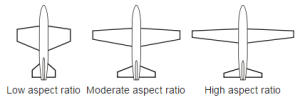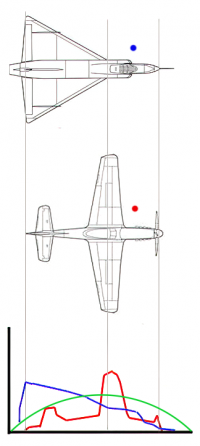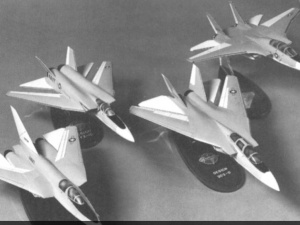Variable-geometry and the demise of the swing-wing
A variable-geometry wing, also known as a VG surface, is a type of lifting surface capable of altering its apparent geometry through a fluid. The most common variety of VG surfaces are variable-sweep, variable-incidence, and variable-camber, which are designed to enhance or modify flight characteristics within a given envelope.
This article will look specifically at the variable-sweep wing, its advantages, disadvantages, and fall from favour among the numerous late 20th century examples, such as F-14, F-111, MiG-23, and Su-17.
Contents
Objectives
The principal impact of changing the lifting surface's sweep is two-fold; it modifies the apparent thickness-to-chord ratio and the aspect ratio. The thickness-to-chord ratio describes the thickness of the surface in relation to the length (the chord) of the surface, whilst the aspect ratio describes the span of the surface regarding the mean length of the surface.
Thickness-to-chord ratio is described by the thickness (b) divided by chord (a), and the aspect ratio is expressed either by the square of the span (s) divided by wing area (A) or span divided by standard mean chord (SMC).
Thickness-to-chord ratio = b / a
Aspect ratio = s^2 / A = s / SMC
Effects
In principle, a higher aspect ratio wing – a long span short chord wing – will suffer less induced drag than a lower aspect ratio wing – a short span long chord wing. This bias is due to the pressure differential generated by the lifting surface. The topside of the airfoil generates a lower pressure region than exists on the underside of the airfoil, which is an intrinsic process of lift. Due to this, underside flow tends to move outwards, while topside flow tends to move inwards, which is expressed significantly at wingtips through the formation of vortices. In this respect, high aspect ratio surfaces suffer less from this vortex formation, as the proportion of flow that moves this way is comparatively less than with a low aspect ratio surface. This effect's practical reality is that high aspect ratio surfaces generate less induced drag in subsonic regimes, leading to high lift to drag ratios which are highly beneficial for efficient long-range subsonic flight.
However, past the drag-divergence Mach number – the Mach number at which airfoil drag increases rapidly – within transonic and supersonic flight regimes, the primary contributor to drag increase becomes wave drag. High aspect ratio surfaces, especially straight unswept surfaces, present a large frontal surface area to incoming flow distributed along a narrow band within the cross-sectional area distribution. As a result, high aspect ratio surfaces generally induce greater wave drag than low aspect ratio surfaces, which is detrimental to transonic and supersonic flight. For wave drag reduction past the drag-divergence Mach number, a thin low aspect ratio surface becomes necessary. A thin, low aspect ratio surface can reduce wave drag and increase the critical Mach number – the point at which local supersonic flow occurs – because of its area distribution and high fineness ratio. This fineness ratio relates inversely to the thickness-to-chord ratio, and apparent fineness can be increased where a thinner wing isn't feasible by increasing the sweep angle.
Variable-sweep
Optimisations for subsonic cruise or supersonic sprint regimes are broadly incompatible, as neither can be optimised without the detriment of the other. Additional practical considerations such as takeoff and landing speeds, especially pronounced on carrier-borne aircraft and poorly equipped airstrips, further drive a wedge between subsonic and supersonic optimisation. To this end, stringent payload, endurance, and sprint requirements lead to variable-sweep wing surfaces as a possible solution to ballooning design weights and high takeoff speeds during the mid-to-late 20th century.
A variable-sweep system allows the utilisation of a high aspect ratio wing, useful for efficient subsonic cruise and enhanced slow-speed handling, while also maintaining a low aspect ratio wing's supersonic efficiency. In particular, the F-14 utilised a CADC (Central Air Data Computer) to continuously optimise the wing based on the current flight parameters, significantly improving efficiency throughout its entire envelope. In other cases, such as Su-17, the pilot may set the sweep position manually to enhance the handling during specific stages of flight. Nevertheless, a swing-wing effectively allows a switch between two drastically opposed flight conditions, which typically aren't simultaneously optimisable. The result is a broader flight envelope in which efficient flight can occur, allowing for improved capabilities within a given design specification.
Demise of the swing-wing
While broadening and providing benefits to the flight envelope, there are a few crucial areas in which variable-sweep surfaces either lack performance or cannot be efficiently optimised.
Observability
There is a correlation between sweep angle and observability within a frontal arc as a rule of thumb. This correlation results from the specular reflection of radar from the planform edges, which is particularly visible at lower sweep angles, resulting in front aspect variable-sweep surfaces being more visible in subsonic/cruise flight regimes. If the observer is perpendicular to a planform edge, specular reflection is particularly strong, which increases the difficulty of observability optimisation when surfaces within the planform are moveable. In general, variable-sweep's nature and the number of possible conditions in which the aircraft can be flown mean a broader array of factors to consider. This more expansive array of conditions generally means unsatisfactory performance regarding RCS reduction efforts across the board, instead of a singular optimisable planform.
Stability
Variable-sweep aircraft suffer some rather large changes in the centre of pressure vs the centre of mass during faster flight conditions (greater sweep). With the centre of pressure moving aft, while the centre of mass remains relatively stationary. Although this change is beneficial for supersonic and transonic flight conditions, low-level flight conditions do not lend well to this resulting nose-heavy lawn dart stability phase of highly swept surfaces. Low-level air currents, which buffet aircraft from below and above as hot and cold air fronts interact with the ground, in turn, act on the centre of pressure of a low flying aircraft. This action can have devastating effects upon highly swept condition variable-sweep craft, with monumental pitching moments being induced due to the centre pressure and centre mass spacing as mentioned above. Thus, in swept states, variable-sweep aircraft are far too stable for some scenarios.
Regarding performance, improvements in flight computers during the later 20th century placed a greater capability within reach through intentionally designed instability. The improved computers were capable of making many constant adjustments without input from the pilot, allowing for intentional instability to enhance manoeuvrability. This development ushered in a new era of unstable fighter aircraft, which allowed for further expanded flight envelopes whilst rendering overly stable configurations – such as highly swept variable-sweep surfaces – obsolete. Furthermore, variable-sweep systems' excess stability generally leads to larger trim required to maintain level flight at high speeds, also requiring larger elevator surfaces to affect the same pitch authority.
While it is possible to design a variable-sweep wing aircraft to be instable, the centre of pressure movement is an unavoidable consequence of such a system. This movement will thus increase stability, negating the purpose and benefits of the instable aircraft.
Complexity & optimisation
Another commonly cited reason for the abandonment of variable-sweep is the weight of such arrangements. Ostensibly, an aircraft with a variable wing is weightier than an aircraft without a variable wing. However, the reality is that this proposition is misguided. While it is true that a variable wing adds additional parts, thus weight, to a given system, the same design for a given set of requirements may, in fact, weigh more without a variable wing. This conundrum is what lead to the adoption of a variable-sweep wing on the F-14. The stringent requirements for intercepts, loiter, and patrol at the ranges and payload stipulated, meant a fixed-wing configuration would've weighed more than a variable configuration. This weight advantage resulted from optimising the wing surface for the specific flight envelope at any given time, where a fixed-wing can only be optimised effectively for a much narrower band of flight. The result is that F-14 is lighter than it otherwise would be due to the variable geometry wing, mainly as it requires less fuel for the same mission profile.
However, fuel storage and mechanical complexity is an issue with variable geometry. Although entirely feasible, storing and accessing fuel in moving surfaces is substantially more difficult than need be. The result is increased leaning upon in-field technical ability when complex fuel systems inevitably require attention. This concern intrinsically links with another consideration – maintenance. Variable geometry surfaces increase system maintenance as a matter of fact. There are more systems than otherwise need be, which adds to ground crew burden. The combination of more systems, which are comparatively complex, with unique systems to variable-sweep aircraft – wing actuators as an example – results in a decrease in practicable readiness, increased costs, reduced strategic mobility, and increased maintenance for every flight hour.
Today the efficiency benefits of variable-sweep surfaces have been reduced to insignificance by current engine development. Modern engines are simply powerful and efficient enough to negate variable-sweep wings' wideband flight envelope benefits and brute force fixed-wing craft up to today's requirements. In contrast, the F-14 needed to possess a variable-sweep wing to achieve the aerodynamic efficiency required to reach its specifications. Instead, a fixed-wing can be optimised to a higher degree in ways that matter more for today's military aircraft, such as RCS and maintenance, than any variable-geometry wing ever could.
Conclusion
When considering the factors mentioned above regarding low-observability, stability, maintenance, and costs, variable-sweep abandonment can be better understood and appreciated as a confluence of elements. Variable-sweep's benefits still exist, but most or all of the required goals can be attained while maintaining non-flight characteristics optimisation through a fixed-wing, where variable-wings fail.
Variable-sweep's benefits can be summarised as the following:
- Broader flight envelope.
- Increased efficiency (continuously variable examples).
- Potentially reduced weight for a given requirement.
The disadvantages, which are more relevant to today's world, can be summarised as the following:
- Increased observability.
- Increased costs, maintenance & complexity.
- Potentially reduced manoeuvrability.







